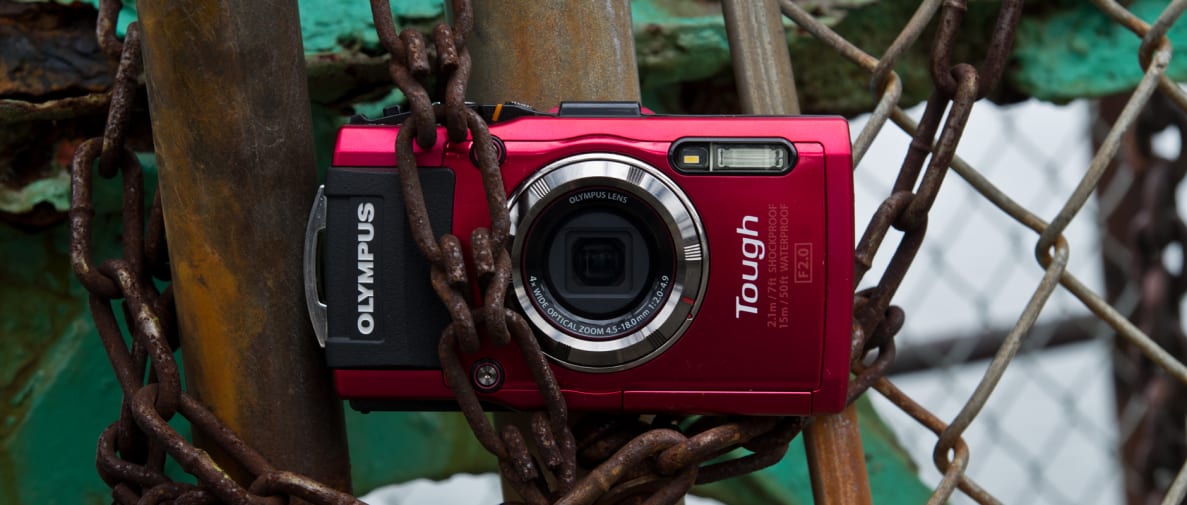Though there are some minor differences compared to last year, the Olympus TG-3 is a powerful pocket camera that is still dead simple to use. Its brand-new WiFi feature is top-notch, and even though the guts of the actual camera haven't improved much, it's still a compelling point and shoot.
Though it suffers from strange metering and saturation issues, a startlingly diverse array of features makes this is one of the most versatile point-and-shoots on the market today. If you're in the market for a toughcam, the TG-3 should be the first one you look at.

Design & Handling
Minor changes, but Olympus sticks with what worked last time.
Unlike most point-and-shoots under $400, the Olympus TG-3 is anything but chintzy. From the tough exterior to the f/2 lens backed up by a 16-megapixel, 1/2.3-inch CMOS sensor, the TG-3 is serious business. With a metallic casing and thoroughly-sealed ports, the TG-3 also can take just about anything you can dish out. Olympus boasts that its TG-3 can withstand 220 pounds of crush force, temperatures down to 14˚F, and keep water out down to 50 feet underwater. After abusing the camera inside the lab and out, I believe it—this is a toughcam worthy of the name.
The TG-3 is a camera that wears its features on its sleeve, offering physical controls for just about everything you'd want. This saves you from having to make trips into the menu, which won't be easy if you're snorkeling underwater. On the back of the camera nestled in next to the screen are a mode dial and a smattering of basic camera function buttons.
All the controls feel quite robust and tactile, and accidental presses are rare—with the lone exception of the mushy video record button, that is. On top you'll find the solid shutter release, awkwardly-placed zoom slider, and power button. They're serviceable, if not ideal.
{{ photo_gallery "tour" }}
Though it's tempting to not mess with a good thing, Olympus decided to drop the quality of the screen found on this camera. Instead of a 3-inch 610k-dot OLED display found on the TG-2, the TG-3 has a 460k-dot LCD of the same size with high reflectivity. It's a puzzling change, and we can't figure out the reason why. It would be one thing if Olympus gave the TG-3 a flip-up screen, such as on the lower-end TG-850, but it seems like a simple cost-cutting move. Is it nitpicking? Sure, but now that we've used the TG-850 we're spoiled. An articulated screen may be just one more moving part that's vulnerable to breaking, but we think it's worth the risk.
However, what the TG-3 lacks in screen, it more than makes up for in connectivity options. Behind dual-locked water- and dust- sealed doors, you can find a full SD/SDHC/SDXC card slot, along with an HDMI (type D) port, and multi-terminal connection. This is great for get-togethers and showing off your snaps; all you'll need to buy is the right cable to share with your TV.
{{ photo_gallery "design" }}
If there was one thing we'd really harp on in terms of design, it's the microphone placement. Because it's at the top of the camera were your left index finger would normally sit, it's easy to accidentally muffle the mic while shooting. Using one hand eliminates this problem, but then you're more likely to wind up with shaky videos. All in all, though, the TG-3 is as well-designed as we've come to expect from Olympus toughcams.
Features
A sturdy cam with a (macro-sized) secret.
At the suggestion that the TG-3 is a tough camera, the natural question to ask is: "Just how tough is it?" Like most other toughcams, it's dustproof and waterproof to a degree, while able to withstand drops of 7 feet. Rated for dives of up to 50 feet, the camera may appear to be a little less hardy than the Canon D30—but consider this: neither camera is going to work well at that depth, so this comparison is largely useless. The Canon might look better on paper, but in the real world, the competition isn't even close—the Olympus camera unquestionably has the better build.
{{ photo_gallery "android-app" }}
If you figured the tough construction is the only feature worth talking about, you'd be dead-wrong. With its Android and iOS app that allow sharing and remote operation over WiFi, Olympus is using the TG-3 to tell the world: "Anything GoPro can do we can do better!" The WiFi app is easily the most polished we've seen to date (save for the one we saw with the Leica T), and much more responsive and easy-to-use than Nikon's attempt. With it, you can access just about every advanced setting on the camera, in an interface that makes good use of both of your thumbs. If you've hated kludgy remote control/sharing apps in the past, this might earn your love back.
With Olympus' free app, you can also share your photos with your smartphone or tablet. You do this by pairing up your device with the camera, which is extremely easy to do. Rather than go through an awkward dance of custom network IDs or entering QWERTY passwords with camera controls, the TG-3 generates a custom QR code that you can simply scan with your phone to link the two devices. Easy peasy. And since this camera is better (and much more durable) than your smartphone's built-in camera, it's a simple way to quickly, easily, and safely take better photos in questionable places that you can share instantly online.
If you're willing to go down the accessory-buying rabbit hole, the front of the camera is home to a rather-unique feature for a point-and-shoot: a mount for adapters and lens accessories. It may seem strange to carry around lens accessories for such a small camera, but sometimes it helps to have a teleconverter or fisheye lens handy. It's not as good as the full interchangeable lens mount on something like the waterproof Nikon 1 AW1, but it's a heck of a lot less expensive.
{{amazon name="Olympus LED Light Guide (LG-1) for Olympus TG-1/2/3", asin="B00JHME2I8", align="right"}}This accessory mount enables some pretty special shooting modes, like a macro/microscope mode that lets you take pictures of objects that are almost touching the lens. Should you need extra light for this, you can pick up the LED light guide, which reflects light from the front-facing LED—so there's no extra fuss coming from bulbs or batteries. If you really like macro photography—and don't want to spend a bundle for a professional setup—the cost of the TG-3 is probably the lowest barrier to entry into this field. The only other waterproof camera that's close is the Ricoh WG-4, but the light here is more powerful since it's drawn from the camera's own flash.
But wait—there's more! Not to be outdone by Nikon's AW120, the TG-3 also boasts a GPS navigation feature—along with its rather pedestrian photo geotagging feature. Though it's really tough to get a lock on your current position in some environments, it's extremely useful if you find yourself taking the road less traveled. Just be aware that there's quite a bit of setup required for this, and it's not as simple as using the feature straight out of the box. Olympus compiled an overview page to describe it, and yes, there's another app you have to download for use with your phone.
Performance
Sharp as a tack, but noisy as a screaming two-year-old
Though competition is closing in on the lens department, the TG-3 has one of the better lenses available in a compact point and shoot. That f/2 lens lets in a bunch more light than those you'd find on most other waterproof point and shoots, allowing the camera to go places and shoot photos that others simply can't take. It's one of those things that should be a no-brainer, but a lot of people buy underwater cameras and don't think to check out how sensitive their new toy is to light. That makes a huge difference even a foot or two underwater, and especially when taking video.
It's no surprise, then, that the TG-3 has among the best video light sensitivity among point and shoots. But that lens isn't a one-trick pony: it's also very sharp. This is especially impressive, given that it doesn't use tricks like aggressive oversharpening to achieve this result—something that most entry-level cameras do to provide the illusion of picture clarity at the expense of haloing around edges.
The TG-3 does take a sharp picture, but it doesn't do so hot with color accuracy. Though it's a common issue with point-and-shoots, the TG-3 is a bit behind the pack here. At no point will your colors reach full saturation, regardless of what settings you use. An untrained eye won't see it, but you'll notice that yellows and greens look a little washed-out. It's a bit of a shame, because landscapes and sunny vacation photos simply look better with punchy, saturated colors. It's fine for most things, but you'll find yourself wanting to push things via editing after the fact, which can be a hassle. The automatic white balance is notably good, though, so the TG-3 is one of the few point and shoots you can leave in auto and not worry about the results.
{{ photo_gallery "sample-photo" }}
If you want to shoot fast-moving subjects, you're in luck. The TG-3 is loaded for bear with three different levels of continuous shooting. If you want full-resolution photos you can shoot at five frames per second. This can be pushed to 15 or even 60 (more like 57 in our tests) frames per second, but only for 3-megapixel images. All three burst modes allow you to capture a healthy 100 images before slowing down, which is especially useful when trying to capture the perfect shot at a sports match or at the beach.
Like most cameras with a small sensor, the Olympus TG-3 also has noise issues. Though there's no option to adjust noise reduction, the camera adds in a lot of junk data to your pictures. If you stick to using ISO 400 and below, you shouldn't find too much issue with it, but just be aware that images you shoot in low light won't be perfect. If you do forge ahead with shooting stills in dim areas, the camera's default noise reduction absolutely destroys any semblance of fine details.
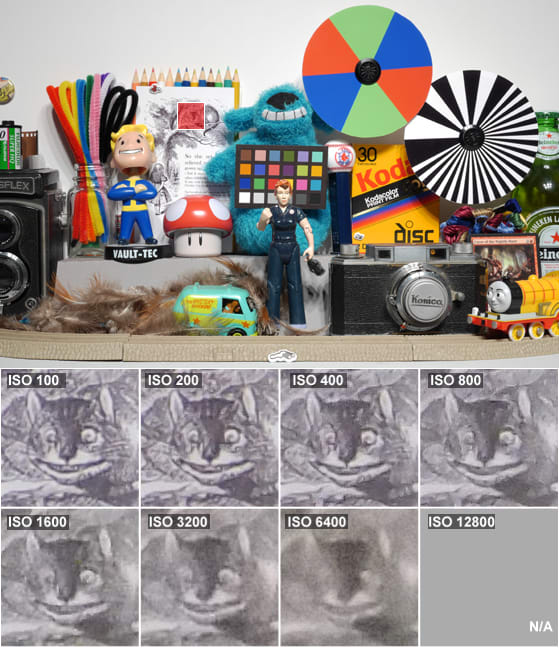
Ultra-aggressive noise reduction destroys detail in low light.
I do want to call out one issue that gave me fits in the lab—and will undoubtedly frustrate you too. Metering with the TG-3 is notably bad. If you're not familiar with what that is, it's how your camera determines the best exposure settings to use in a given lighting situation. When you want to take a snap, the camera will measure the light hitting the sensor, adjust its settings, and fire. However, you might notice that many of your shots don't look right, are too bright, or way too dark. It doesn't happen with every shot, but if you notice that the TG-3 is giving you shots that are too light or too dark for some reason, the exposure compensation setting will help smooth things out.
Conclusion
Adventure is out there; the TG-3 is ready.
We had high hopes for the TG-3 given how much we enjoyed its predecessor, and the TG-3 definitely lives up to last year's model. Though far from perfect, an improved featureset on the TG-3 means you're buying a camera with the tools to do everything you ask and much more. Very rarely are point and shoots cameras a good option to grow with, but the TG-3 can give you a little taste of variety in the photography world without breaking the bank.
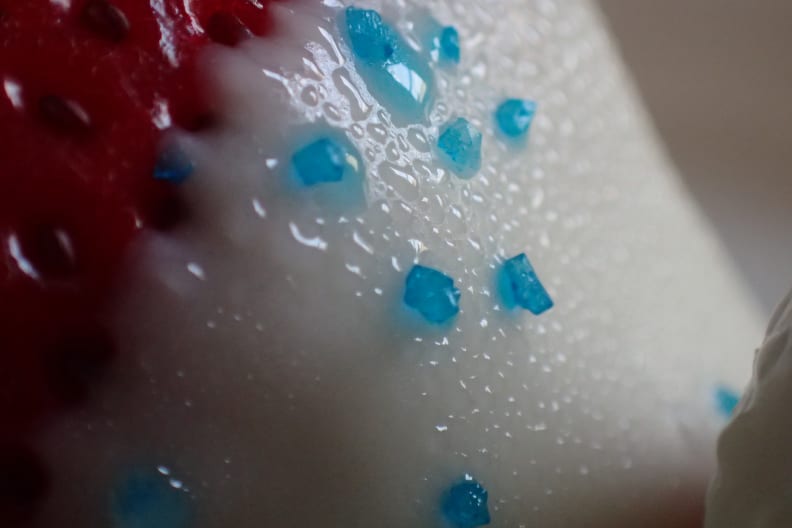
Microscope mode is really fun, okay?
And that's really the best thing you could ask for in a cheap camera. There are a lot of stinkers out there, and many phone it in to reach a certain price point. Even amongst the waterproof segment, there are a few cameras that simply charge more because they can survive a quick dip in the pool. Not so for the Olympus toughcam—it has a full set of features that not only are very helpful in the age of smartphones, but also provide a compelling reason to buy a standalone camera instead of relying on your mobile. It's simply a good camera that also happens to be able to weather some abuse.
Point-and-shoots are something of an endangered species. But even a new wave of waterproof smartphones can't go the places that the TG-3 can. That's valuable, especially given how well the TG-3's WiFi plays with your average Android or iOS device. That makes the Olympus TG-3 a fantastic option to take with you on your adventures.
It's still a bit on the pricey side of a point-and-shoot, but what you get for $349.99 is far more than what you get with competitor touchcams like the Canon D30. It's certainly a strong contender for our 2013 waterproof camera of the year right alongside the Nikon AW120.
We're just putting our finishing touches on all of our waterproof camera reviews for 2013, but it's clear that Olympus is once again the front-runner in the category. With smartphone cameras improving by leaps and bounds it's getting harder and harder to justify shelling out for a dedicated point-and-shoot. The Olympus TG-3 makes a very compelling case, though, as a camera that can follow you just about anywhere and live to tell the tale.
By the Numbers
Point and shoots don't typically have a high ceiling, so we have to temper our expectations a bit. That said, this is a wildly inconsistent camera. For every great result, there's a not-so-great one. On the whole, the TG-3 averages out to be pretty good, but that's mostly due to features, and not raw performance. It's not a major step forward for the category or Olympus in particular, but it's a good all-around toughcam that doesn't backtrack from its predecessor.
Color & White Balance
Ugh.
It's tough to start on a sour note, but color accuracy on the TG-3 just isn't where it needs to be. Granted, its ∆C00 color saturation error is at an acceptable 2.78, but for whatever reason you can't coax out near 100% overall color saturation in any color setting. It's frustrating for two reasons: First, generally cameras keep saturation to a minimum in order to produce more accurate images; Second, the kinds of shots you're likely to take with the TG-3 (landscapes, vacation pics) will simply look better with a little more punch to them.
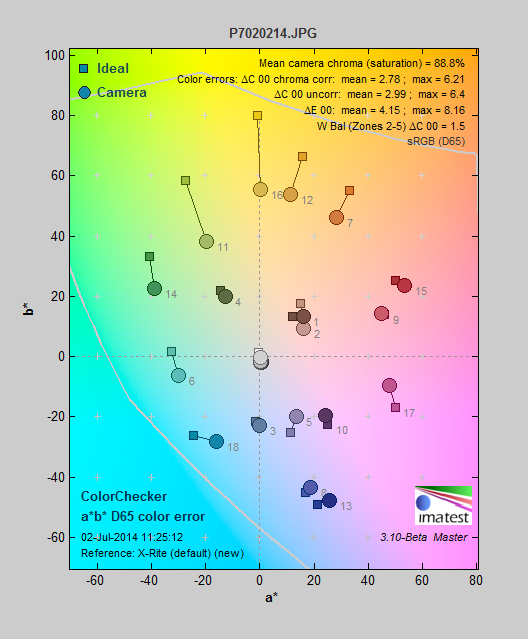
Muted color mode gives you the most accurate results, but Vivid maintains the best saturation.
Not all colors are de-saturated, but yellows and greens suffer the most here. This means that most vegetation will look less vibrant than it should. It's a big disappointment, sure, but one that can be fixed with a few minutes of futzing in Photoshop.
To sweeten things up a bit, automatic white balance is actually quite good. For point-and-shoots, tungsten-filament lighting typically pushes color temperature error to over 1,000 kelvin away from where it should rest. However, the TG-3 never moved past 600 in any reading we took, and averaged under 450 kelvins. That's unheard-of for most cameras, especially in a point and shoot.
Sharpness
Tack-sharp, with some errors
Moving onto better news, that lens on the TG-3 sure is something for a point-and-shoot. In addition to its super-wide aperture (for a point and shoot, anyway) of f/2, it also is respectably sharp through most focal lengths. There's a bit of chromatic aberration in there in the form of blue haze over areas of sharp contrast, but otherwise the TG-3 posts a great result.
Due in part to the chromatic aberration, you won't see the ever-so-slight haloing around some of the edges due to oversharpening. It also doesn't hurt that we couldn't really find many soft edges, even at the extremes of our test shots. This is a solidly sharp lens/sensor team, especially if you're not planning on printing massive versions of your photos.
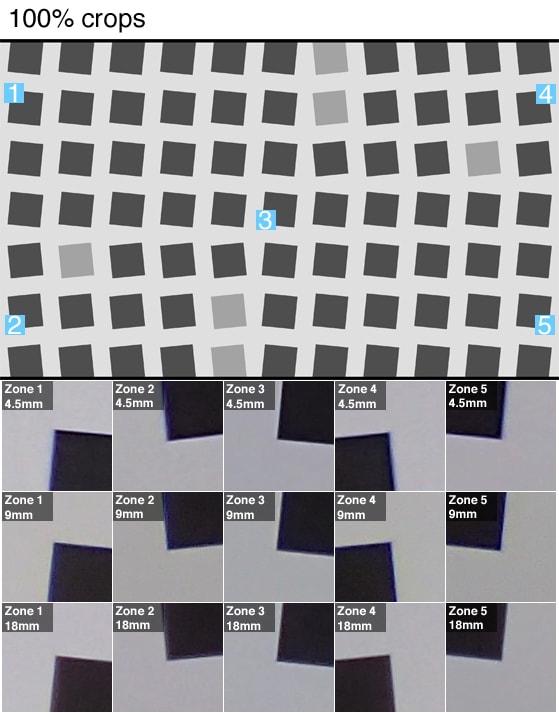
There's a bit of chromatic aberration, but very little oversharpening.
I will point out that the camera is diffraction limited at the longest focal length, meaning you'll notice some pretty crappy shots when you go pixel-peeing on shots taken at full telephoto. It's not a very pronounced problem, but one that exists nonetheless. Be sure to keep your ISO low so the noise-reduction algorithm doesn't completely destroy your photos, and stick to the wide end of the zoom range in low light.
Noise
Big noise from little sensor.
If you're looking for pristine shots from a camera in low light, then the TG-3 isn't your camera. Some noise is fine, but this point and shoot in particular hits the perceptible 1% mark at about ISO 400. That's pretty bad—common in its category, but still pretty bad compared to what interchangeable lens cameras—even entry-level ones—can do.
To make matters worse, the TG-3 has a rather aggressive noise reduction algorithm that absolutely crushes fine detail into a blotchy mess. You won't notice this at ISO 100 or 200, but from 400 and higher detail quickly gives way as the camera tries to eliminate any trace of noise. It's something we see in just about every point-and-shoot and while noisy photos aren't ideal, without the ability to shoot in RAW it's all you can get from the TG-3 in low light.

Ultra-aggressive noise reduction destroys detail in low light.
Video
Good, bad, and ugly
Video remains a sore spot for Olympus' toughcams, though the TG-3 is an odd duck, to be sure. Great low light sensitivity is unfortunately undone by terrible sharpness, making for a camera that can take video with far less light than other point and shoots—but it's not great quality.
To put numbers behind that claim, we were able to get the camera shooting video that hit 50 IRE on waveform monitor right down to 4.5 lux. We typically see entry-level point and shoots peter out at about 9-12 lux, so this is a very respectable performance point.
It's when you get to sharpness that it goes out the window. Even in bright light, the TG-3 is only able to resolve 525 lw/ph horizontally, and 475 lw/ph vertically. That's not the worst that we've seen horizontally, but the astigmatism vertically . But it gets worse in low light—the same measurements drop to 450 lw/ph and 425 lw/ph respectively.
When the rubber hits the road, you'll notice some trailing and frequency interference issues in your video clips. This is definitely not a camera you want to be using to replace a camcorder, but it's slightly better than your average smartphone and will produce at least something in low light.
Meet the tester
A seasoned writer and professional photographer, Chris reviews cameras, headphones, smartphones, laptops, and lenses. Educated in Political Science and Linguistics, Chris can often be found building a robot army, snowboarding, or getting ink.
Checking our work.
Our team is here for one purpose: to help you buy the best stuff and love what you own. Our writers, editors, and lab technicians obsess over the products we cover to make sure you're confident and satisfied. Have a different opinion about something we recommend? Email us and we'll compare notes.
Shoot us an email

